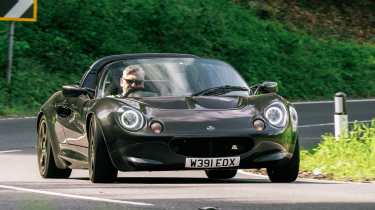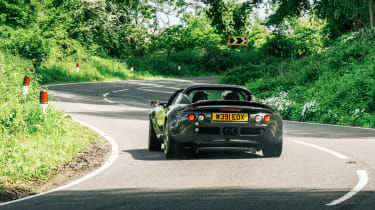Analogue Lotus Elise SuperSport review: the Elise perfected?
Based on the Series 1 Lotus Elise, the Analogue SuperSport is driving stripped down to its bare essentials; it's brilliant
I knew it as soon as John Barker dropped a gear and screamed past the dawdling Toyota Avensis ahead. Giving chase in my mostly standard S1 Elise I fumbled into second gear and pulled out to overtake, throttle against the stop, and watched the squat, jet-black car grow smaller and smaller in front. Stones were pinging from under its aluminium diffuser as if to ward me off the pursuit, and after just a moment or two I'd fallen well outside the danger zone. The Analogue Elise SuperSport is a different animal, and getting a taste of it might just cost me a large sum of money in new parts…
Other sports cars have come and gone, but the brilliance of Lotus’s part-aluminium, part-plastic roadster has persisted since it arrived in 1996. To this day, few – if any – cars have the same lightness of touch and rich feedback as an Elise, so if you're going to tamper with that carefully curated recipe, you need to know what you're doing. Analogue Automotive does. Its Elise SuperSport restomod is spellbinding.
In a nutshell, the SuperSport is a comprehensively re-engineered S1 Elise built from the ground up to be faster, more exciting and more polished than the original which, lest we forget, was developed with a close eye on costs to make it accessible to the masses. Analogue's creation is pitched at a significantly more wealthy audience with a price north of £100k in fully specced form but, with bespoke componentry and 600-700 hours of labour behind it, the end result is a modernised Elise finished to a far higher standard than the base car.
More reviews
Group tests
In-depth reviews
Reviews
A much, much quicker one too. With an uprated 210bhp Rover K-series motor, the SuperSport generates the thick end of 100bhp more than the 1996 original, and at 695kg it’s even lighter thanks to unique wishbones, hubs and a smattering of carbonfibre parts. The core aluminium chassis is retained and treated for corrosion, but everything bolted to it is either new or refinished. Those bespoke wishbones give the SuperSport a wider track than standard, and work with three-way adjustable Nitron NTR46 coilovers that appear to chop entire inches from the ride height.
I’ve brought my own S1 Elise along to Analogue’s Hampshire base as a reference point for the SuperSport, and it looks like a beach buggy sitting next to it. Crucially though, Lotus guru and company founder Steffen Dobke has designed the chassis modifications to preserve the trademark compliance of the original, drawing from two decades of Elise ownership and suspension setup experience.
Harnessed into a snug-fitting carbon-shelled bucket, with the modified K-series pulsing away, the SuperSport is permeated with an intensity I haven’t felt in an Elise before. The environment is familiar, but there’s a more serious, almost sinister energy about the car; the engine is more vocal, the control weights are beefier and you sit even lower in the chassis. With a chunk more torque – 160lb ft to my car’s 128 – the SuperSport feels even more weightless under light throttle openings, and there’s an immediate directness to the ride on those Nitron coilovers. It’s no more harsh than a normal S1, in fact it's a little better at filtering out fine imperfections, but the SuperSport follows the contours of the road where the standard setup laps them up within its suspension travel.
This is fed back through the steering, which is heavier and relays stronger messages from the surface beneath and truly connects you to the car. This overriding sense of connection isn’t marred by the usual Elise undertray clatter over bumps, either; the SuperSport feels rock solid thanks to sound insulation that filters out resonances through the car’s aluminium construction. With genuine carbon trim and new switchgear in place of the old plastic Peugeot items, the cabin quality backs up the depth of engineering elsewhere.
Every Analogue Elise gets a close-ratio PG1 gearbox rebuilt with a Quaife ATB limited-slip diff and a short-shift gear change, and it really is short; there’s a tight, heavy action across the gate and into gears that takes some getting used to. It all culminates in a more physical driving experience, and one of eye-widening intensity when you explore what the SuperSport can really do.
When the road straightens out and I bury the throttle for the first time, the SuperSport is breathtaking; it snaps forward in a flurry of induction roar, and real ferocity as it nears the redline (just shy of 7500rpm). I can scarcely believe I’m still driving an Elise. The standard car has an exciting yet accessible level of performance, but the SuperSport feels frantically quick and goes into warp drive when the motor comes on song. It’s a good thing, then, that the information coursing through the steering and chassis gives you confidence to carry speed when the road meanders once more.
Turn in and the suspension loads up instantly where an Elise would normally need to settle on its springs, and from there, it’s a case of chasing the throttle and overdriving the rear wheels to your heart's content. As ever, the Elise’s compact footprint means there’s so much space to work with, giving you freedom to exploit that wonderful mid-engined balance and exit corners with a twist of opposite lock if you wish. But there’s a new dynamic character here, and one that you won’t recognise from a standard Elise; the extra roll support and cornering potential of the SuperSport mean that most of the light-footed mid-corner adjustability has been dialled out, in its place a more incisive and buttoned-down chassis.
On track, where you can carry more speed and put higher loads through the car, this extra control gives you much more confidence. You can be more aggressive than in a standard Elise without the threat of a big weight transfer upsetting the balance, and the beefier, more connected steering keeps you keyed into the available grip levels. For me, managing the Elise's rearward weight balance and using it to your advantage is a defining part of the driving experience, but the SuperSport offers different, more intense rewards – particularly in the exit phase of corners, where you can use the extra power and Quaife diff to steer on the throttle as you might in a Caterham.
In fact, my overriding impression of the Analogue car is that its character has shifted further towards a Seven, with its heavier controls, more connected feel and rampant, full-throated power delivery. More than once, I found myself peering down at the peaks of the wheel arches through the windscreen to remind myself that I was in an Elise. Driving home from Analogue’s workshop in my car, there was no doubt. The Elise’s distinctive characteristics – the ones that led me to buy one – were suddenly crystal clear again, from the light, delicate steering to its natural chassis flow and playful mid-corner attitude.
That said, both Elises are undoubtedly five-star cars; the SuperSport is terrific, blending an intoxicatingly raw driving experience with underlying compliance and much better finishing standards than Hethel could manage all those years ago. But it's also a reminder that a standard S1 Elise will always be something to savour in its own right.
| Engine | In-line 4-cyl, 1796cc |
| Power | 210bhp @ 7250rpm |
| Torque | 160lb ft @ 5900rpm |
| Weight | 695kg |
| Power-to-weight | 307bhp/ton |
| 0-60mph | 4.5sec |
| Top speed | 140mph |
| Price | c£100,000 |







